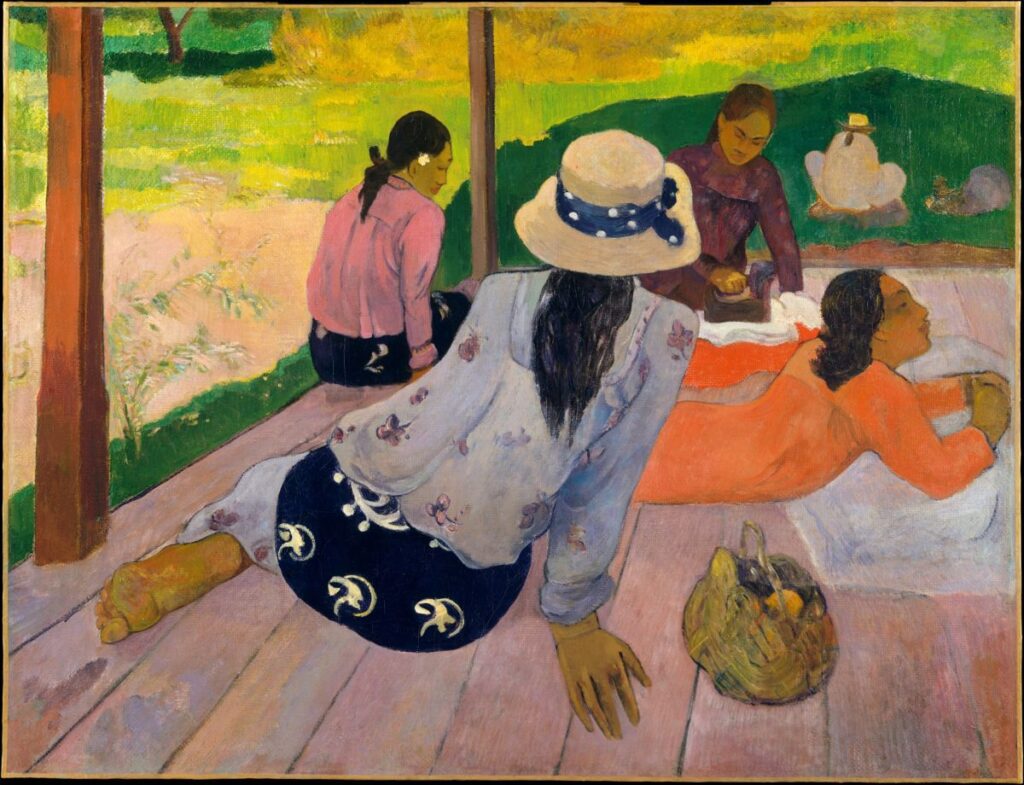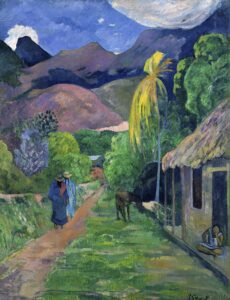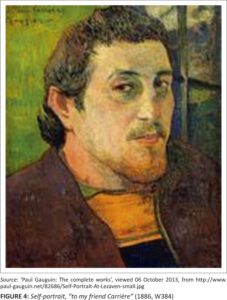
SUMMARY: An exhibit at the National Gallery of Art was intended to dispel Paul Gauguin’s South Seas image but will probably romanticize it even more. The most complete Gauguin show in more than eight decades, ‘The Art of Paul Gauguin” is astonishing in its beauty and variety, embodying the power of desire and spiritual significance.

The Art of Paul Gauguin” was mounted with the worthy aim of laying the romantic South Seas “Moon and Sixpence” myth to rest and resurrecting Gauguin the artist through a definitive scholarly exhibition.
It hasn’t quite worked out that way. This astonishing and beautiful show will only expand the myth tenfold. What emerges from this exhibit — at Washington’s National Gallery of Art through July 31 and then traveling to the Art Institute of Chicago and the National Galleries of the Grand Palace in Paris — is that the artist still looms larger than his masterpieces.
In fact, the known masterpieces tell only half the story. Among the strangest objects in the show is a small 1889 stoneware pot modeled in a grotesque, tortured likeness of the artist. This leap from the technical to the literary and autobiographical is typical of Gauguin: He made little distinction between his art and his life.
Organized by a team of curators from the National Gallery, the Art Institute and the National Museums of France, this is surely one of the decade’s great exhibitions. The most complete Gauguin show since the 1906 Paris memorial exhibition, it is overwhelming in its content, its beauty, its momentum and its variety. The ceramics are just one of its fascinating revelations.
Besides its 97 superb oils, the National Gallery show includes some 31 ceramic and wood vessels and sculptures, and 151 drawings, gouaches, watercolors and prints in an astounding array of techniques, many invented by Gauguin himself. Adding immensely to the American Telephone & Telegraph Co-funded exhibition are 11 luminous oils from Soviet museums. Just one alone is worth a visit. “Te Arii Vahine” (“The Noble Woman”)- from the A. S. Pushkin State Museum of Fine Arts in Moscow belongs to the line of great pastoral nudes beginning with Giorgione. Sadly missing is his culminating masterpiece: the Boston Museum of Fine Arts’ legendary mural-size panel, “Where Do We Come From? Who Are We? Where Do We Go?” It was on the list but proved too fragile to travel.
However, it fits the artist’s creed to tantalize the viewer with treasures still unseen. “Soyez mysterieuse” (“Be mysterious”) was one of his favorite mottos. It is seen several times in this show, most prominently on the left panel of his decorative masterpiece, the elaborately carved door frame to the studio and bedroom of his house on the Marquesas Islands.
“House of Pleasure” is carved in large letters on the lintel of this gateway to Gauguin’s final escape. “Be in love and you will be happy” is the accompanying motto on the right.
These mottos, ostensibly addressed to the women in his life, became the leitmotivs of Gauguin’s career, but he had to work extraordinarily hard to give them the resonance he wanted. One has the feeling, throughout this exhibition, that he felt like a chrysalis with long-buried instincts to guide him toward his desired metamorphosis.
Gauguin was an Impressionist for more than a decade before rejecting its materialist approach to subject matter and style. A stockbroker by trade, he started painting as an avocation in 1874 when he was 26. By 1876 he had made such rapid progress that he was juried into the annual state-sponsored Salon. This is a far cry from the Gauguin of legend, who suddenly took up art at the age of 42 and sailed off to pursue a bohemian life in the South Seas.

Although he was largely self-taught, he had help, particularly from the Impressionist Camille Pissarro, whose short diagonal brushstrokes, rich use of greens and moody tonalities are an obvious influence. However, Gauguin soon felt suffocated by the Impressionist mission of imitating the operation of light as it strikes the eye. “The Little Dreamer,” an 1881 painting of his sleeping daughter Aline, is full of poetic touches; the wallpaper, decorated with birds in flight, suggests the winged fancy of the child’s dreams.
The painting is a clear forerunner of one of Gauguin’s most famous Tahitian paintings, “Manao Tupapau” (“The Specter Watches Over Her”). In “Noa Noa,” the artist’s highly embroidered account of his first trip to Tahiti, he tells of startling his native child bride at night and seeing in her eyes the scar of “those legendary demons or specters, the Tupapaus, that filled the sleepless nights of her people.”
The stock market crash of 1882 seemed only to stiffen Gauguin’s resolve to become an artist. By that time he had four children. One more was bom before his Danish wife, Mette, became disgusted with the family’s worsening finances and took the children back to Copenhagen.
A wooden box carved in the mid-1880s has often been interpreted by critics as the artist’s sardonic comment on his wife’s preoccupation with money. However, the. mask-like heads that decorate this box are also the first signals of Gauguin’s passion for folk and tribal arts. A primitivist spirit appears in his sculpture and ceramics long before any traces of it show up in his paintings.
The artist began to work with fired clay in 1886 under the guidance of Ernest Chaplet. His early ceramic pieces, mostly figurative pottery in brown stoneware, were strongly influenced by the Peruvian pottery he remembered from Lima, where he lived with his mother’s relatives during his childhood.
These cunning little cups and vases display an extraordinary inventiveness in the tactile handling of clay. They are also very bold for their time. Gauguin violently rejected the decorated porcelain that dominated French ceramics and praised the work of American Indians.
Strangely, he began to look more and more like the beak-nosed Indians that adorn Peruvian pots. He dressed to emphasize the resemblance, wearing his hair low on his brow and scowling fiercely to better resemble the savage he felt himself to be inside.
In the small Brittany village of Pont-Aven, where Gauguin settled in July 1886, he established a pattern that he was to follow for the rest of his life. First he studied the inhabitants and environment with almost an ethnographer’s eye, noting the details of native dress, geography, vegetation and local customs. Then when he had a store of carefully drawn motifs, he integrated them in imaginative paintings, using the history of world art for compositional sources and subjects.
A particularly rich example of an imaginatively enhanced landscape is the privately owned “The Swineherd.” It has the magical aura of a fairy tale. In other Pont-Aven paintings, such as “Young Bretons Bathing” and “Children Wrestling,” one can see Gauguin’s growing appreciation for the elegant linear qualities of Japanese art, so different from the dappled brushstrokes of Impressionism.
Judging from the evidence of this exhibition, however, it was Vincent van Gogh who was the unacknowledged source of Gauguin’s liberation from conventional thinking about color and form in painting. At the time, Gauguin had advanced theories, but van Gogh was making revolutionary art. Gauguin’s brief and troubled stay in Arles with van Gogh from October to December of 1888 was decisive for his conversion to a symbolic and abstract use of color and line.
During and after that visit, a series of remarkable masterpieces seemed to flow from Gauguin’s hand, culminating in “The Yellow Christ” and “Christ in the Garden of Olives,” both from 1889. The latter is a self-portrait, a provocative example of self dramatization that annoyed his colleagues.
By 1889, Gauguin was the acknowledged leader of a new generation of painters who successfully challenged the Impressionists on the issue of expressive color and form. But Brittany had already become stale for him and he dreamed of the South Seas, where he hoped to find his spiritual home. He embarked for Tahiti in April 1891.
He knew exactly what he wanted to find there. Even when the reality fell far short of his expectations, he painted the islands and its native beauties as the paradise he had visualized before he left.
“The Siesta,” “The Meal,” “Street in Tahiti” are all based on observed reality, although it has been altered in the interests of obtaining a richer, more decorative color and composition. At the same time, Gauguin painted such magnificent imaginative compositions as the Metropolitan Museum of Art’s famous “la Orana Maria” (“Hail Mary”), a Tahitian interpretation of the Annunciation.
In this painting as in many others, Gauguin uses Indian sculptures from the Buddhist temple at Borobudur as source material for his figures’ poses. He had always been stylistically eclectic, but in Tahiti, his eclecticism began to assume a philosophical and religious significance. Although he was anticlerical, Gauguin was deeply attracted to the idea of the essential kinship of all religions.
The richest and most unfamiliar lode of works in the exhibition can be found in the final galleries curated by Richard Bretell. These document the artist’s stay in France from 1893 to 1895 and his final eight years in Tahiti and the Marquesas. Bretell has done a superb job of culling the mass of available material, which includes numerous woodcuts, drawings and illustrations, notebooks, manuscripts and sculpture as well as paintings.
During his last years, Gauguin’s paintings developed steadily in the complexity of their iconography and their deep and sonorous colors. Standing in the gallery filled with the enigmatic multifigure paintings from this late period is an unforgettable visual experience. Instead of imposing his desires on the landscape, Gauguin had finally transformed himself into the seer he wanted to be. He painted visions as they welled up inside him, some of them tragic, some of them amazingly peaceful, given his frantic life at the time.
What are we to make of Gauguin, with his incredible egotism, his flair for self dramatization, his gifts for self-promotion at the expense of others and his incontestable visionary genius? No doubt his character was flawed, but by the end of this exhibition, Gauguin’s favorite motto, “Be in love and you will be happy,” transcends its erotic connotations and takes on a spiritual significance. His art embodies the eternal power of human desire to transform the world in its own image.
Jane Addams Allen 1988
Volume 33 no 4 March / April 2019

